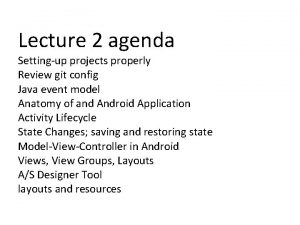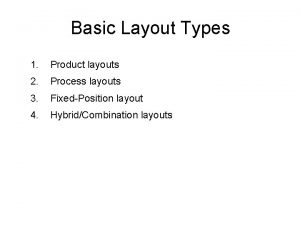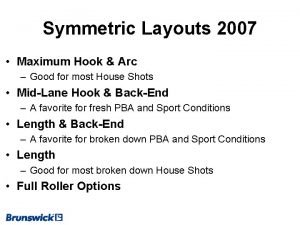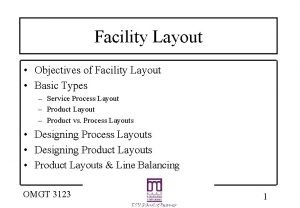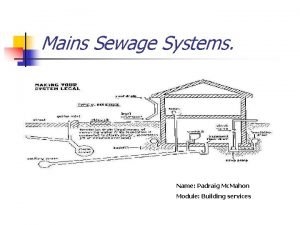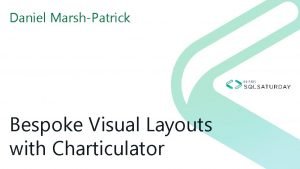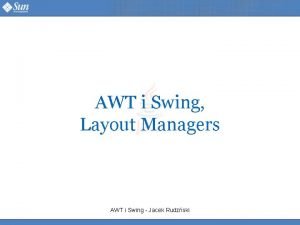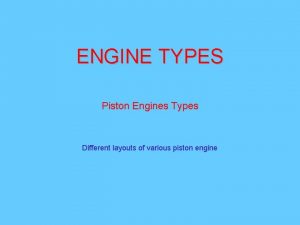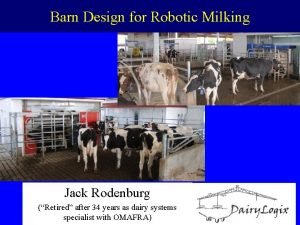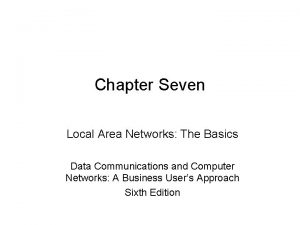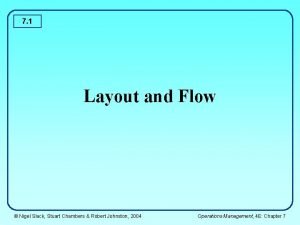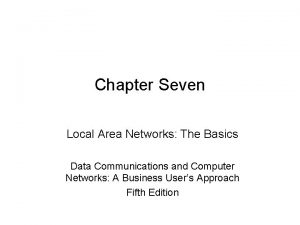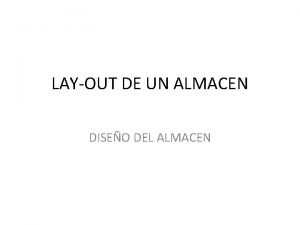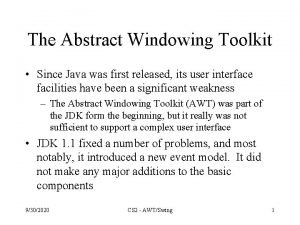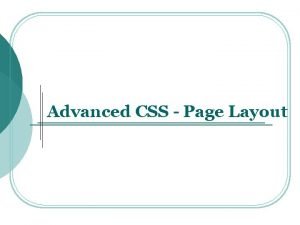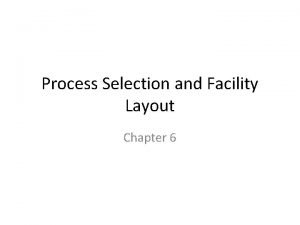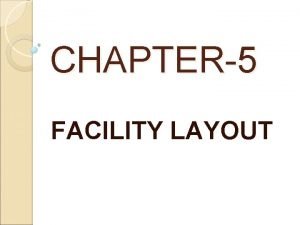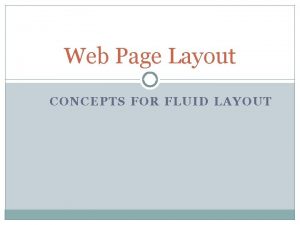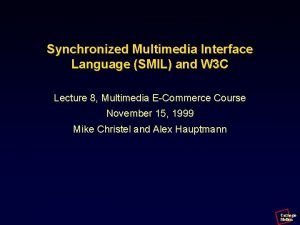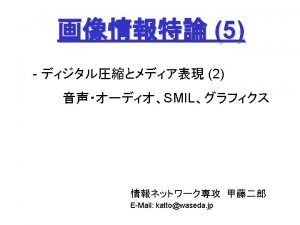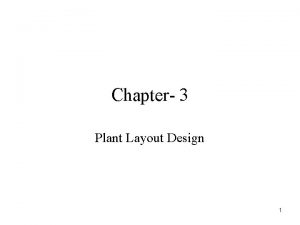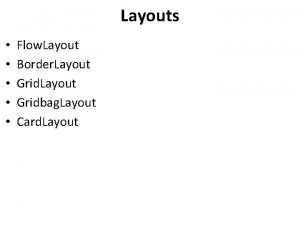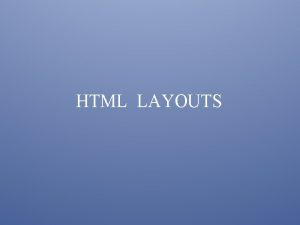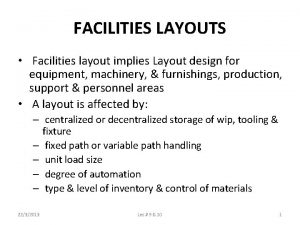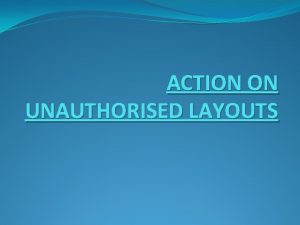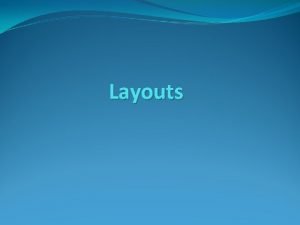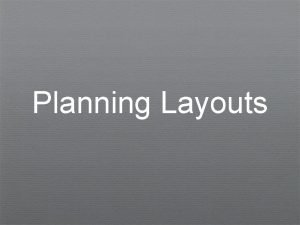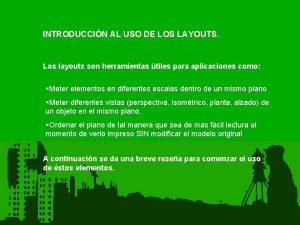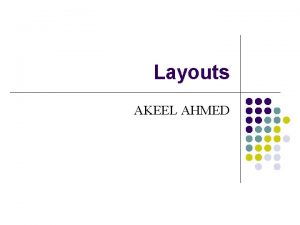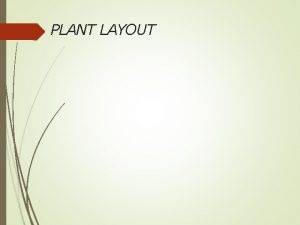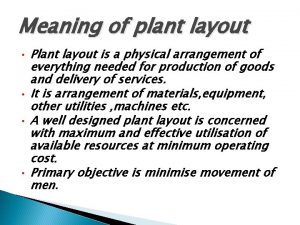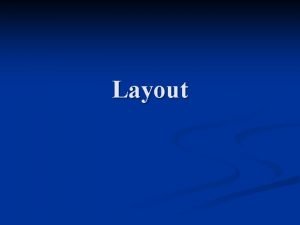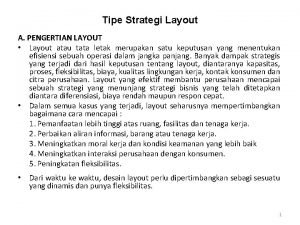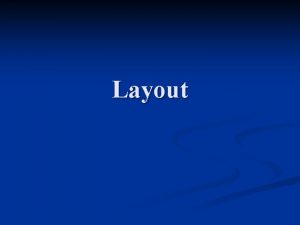PLANT LAYOUTS PLANT LAYOUT Plant layout refers to


























- Slides: 26

PLANT LAYOUTS

PLANT LAYOUT Plant layout refers to the arrangement of physical facilities such as machinery, equipment, furniture etc. with in the factory building in such a manner so as to have quickest flow of material at the lowest cost and with the least amount of handling in processing the product from the receipt of material to the shipment of the finished product.

DEFINITION According to Riggs, “the overall objective of plant layout is to design a physical arrangement that most economically meets the required output – quantity and quality. ” According to J. L. Zundi, “Plant layout ideally involves allocation of space and arrangement of equipment in such a manner that overall operating costs are minimized.

IMPORTANCE OF PLANT LAYOUT • It is long-term commitment • It facilitates the production process, minimizes material handling, time and cost, and allows flexibility of operations • It facilitates easy production flow, makes economic use of the building, promotes effective utilization of manpower, and provides for employee’s convenience, safety, comfort at work, maximum exposure to natural light and ventilation. • it affects the flow of material and processes, labour efficiency, supervision and control, use of space and expansion possibilities.

OBJECTIVES OF PLANT LAYOUT • Proper and efficient utilization of available floor space • To ensure that work proceeds from one point to another point without any delay • Provide enough production capacity • Reduce material handling costs • Reduce hazards to personnel • Utilize labour efficiently • Increase employee morale • Reduce accidents • Provide ease of supervision and control • Provide employee safety and health • Allow ease of maintenance • Allow high machine or equipment utilization • Improve productivity • To minimize cost of productions • Better inter department relationship

TYPES OF LAYOUTS 1. 2. 3. 4. PRODUCT OR LINE LAYOUT PROCESS OR FUNCTIONAL LAYOUT FIXED POSITION OR LOCATION LAYOUT COMBINED OR GROUP LAYOUT

1. PRODUCT OR LINE LAYOUT Under this, machines and equipments are arranged in one line depending upon the sequence of operations required for the product. The materials move from one workstation to another sequentially without any backtracking or deviation. Under this, machines are grouped in one sequence. Therefore materials are fed into the first machine and finished goods travel automatically from machine to machine, the output of one machine becoming input of the next.

e. g. in a paper mill, bamboos are fed into the machine at one end and paper comes out at the other end. The raw material moves very fast from one workstation to other stations with a minimum work in progress storage and material handling. The grouping of machines should be done keeping in mind the following general principles. a) All the machine tools or other items of equipments must be placed at the point demanded by the sequence of operations. b) There should no points where one line crossed another line. c) All the operations including assembly, testing, packing must be included in the line


ADVANTAGES OF PRODUCT LAYOUT 1. 2. 3. 4. 5. 6. 7. 8. 9. Low cost of material handling, due to straight and short route and absence of backtracking. Smooth and uninterrupted operations Continuous flow of work Lesser investment in inventory and work in progress Optimum use of floor space Shorter processing time or quicker output Less congestion of work in the process Simple and effective inspection of work and simplified production control Lower cost of manufacturing per unit

DISADVANTAGES OF PRODUCT LAYOUT High initial capital investment in special purpose machine 2. Heavy overhead charges 3. Breakdown of one machine will hamper the whole production process 4. Lesser flexibility as specially laid out for particular product. 1.

SUITABILITY OF PRODUCT LAYOUT 1. 2. 3. 4. 5. Mass production of standardized products Simple and repetitive manufacturing process Operation time for different process is more or less equal Reasonably stable demand for the product Continuous supply of materials Therefore, the manufacturing units involving continuous manufacturing process, producing few standardized products continuously on the firm’s own specifications and in anticipation of sales would prefer product layout e. g. chemicals, sugar, paper, rubber, refineries, cement, automobiles, food processing and electronics etc.

2. PROCESS OR FUNCTIONAL LAYOUT In this type of layout machines of a similar type arranged together at one place. E. g. Machines performing drilling operations are arranged in the drilling department, machines performing casting operations be grouped in the casting department. Therefore the machines are installed in the plants, which follow the process layout. The work, which has to be done, is allocated to the machines according to loading schedules with the object of ensuring that each machine is fully loaded. Used when the operations system must handle a wide variety of products in relatively small volumes (i. e. , flexibility is necessary)

The grouping of machines according to the process has to be done keeping in mind the following principles – 1. The distance between departments should be as short as possible for avoiding long distance movement of materials. 2. The departments should be in sequence of operations 3. The arrangement should be convenient for inspection and supervision



ADVANTAGES OF PROCESS LAYOUT 1. 2. 3. 4. 5. 6. Lower initial capital investment in machines and equipments. There is high degree of machine utilization, as a machine is not blocked for a single product The overhead costs are relatively low Change in output design and volume can be more easily adapted to the output of variety of products Breakdown of one machine does not result in complete work stoppage Supervision can be more effective and specialized There is a greater flexibility of scope for expansion

DISADVANTAGES OF PROCESS LAYOUT Material handling costs are high due to backtracking More skilled labour is required resulting in higher cost. Time gap or lag in production is higher Work in progress inventory is high needing greater storage space More frequent inspection is needed which results in costly supervision

SUITABILITY OF PROCESS LAYOUT Products are not standardized Quantity produced is small There are frequent changes in design and style of product Job shop type of work is done Machines are very expensive Thus, process layout or functional layout is suitable for job order production involving non-repetitive processes and customer specifications and non-standardized products, e. g. tailoring, light and heavy engineering products, made to order furniture industries, jewelry.

3. FIXED POSITION OR LOCATION LAYOUT In this type of layout, the major product being produced is fixed at one location. Equipment labour and components are moved to that location. All facilities are brought and arranged around one work center. This type of layout is not relevant for small scale entrepreneur. E. g. - shipbuilding


ADAVANTAGES OF FIXED POSITION LAYOUT It saves time and cost involved on the movement of work from one workstation to another. 2. The layout is flexible as change in job design and operation sequence can be easily incorporated. 3. It is more economical when several orders in different stages of progress are being executed simultaneously. 4. Adjustments can be made to meet shortage of materials or absence of workers by changing the sequence of operations. 1.

DISADVANTAGES OF FIXED POSITION LAYOUT Production period being very long, capital investment is very heavy Very large space is required for storage of material and equipment near the product. As several operations are often carried out simultaneously, there is possibility of confusion and conflicts among different workgroups.

SUITABILITY OF FIXED POSITION LAYOUT Manufacture of bulky and heavy products such as locomotives, ships, boilers, generators, wagon building, aircraft manufacturing, etc. Construction of building, flyovers, dams.

4. COMBINED OR GROUP LAYOUT Certain manufacturing units may require all three processes namely intermittent process (job shops), the continuous process (mass production shops) and the representative process combined process In most of industries, only a product layout or process layout or fixed location layout does not exist. Thus, in manufacturing concerns where several products are produced in repeated numbers, Generally, a combination of the product and process layout or other combination are found in practice.

e. g. for industries involving the fabrication of parts and assembly, fabrication tends to employ the process layout, while the assembly areas often employ the product layout. In soap, manufacturing plant, the machinery manufacturing soap is arranged on the product line principle, but ancillary services such as heating, the manufacturing of glycerin, the power house, the water treatment plant etc. are arranged on a functional basis.
 Android layouts
Android layouts Characteristics of product layout
Characteristics of product layout Event handling in swing
Event handling in swing Full roller layouts
Full roller layouts Objective of facility layout
Objective of facility layout Underground drainage layouts
Underground drainage layouts The main issue in designing process layouts concerns what
The main issue in designing process layouts concerns what Power bi tips layouts
Power bi tips layouts Swing layouts
Swing layouts Types of piston
Types of piston Mal layouts
Mal layouts Robot dairy barn design
Robot dairy barn design What are the basic layouts of local area networks
What are the basic layouts of local area networks Layout and flow operations management
Layout and flow operations management What are the basic layouts of local area networks
What are the basic layouts of local area networks Layouts almacen
Layouts almacen Abstract windowing toolkit
Abstract windowing toolkit Advanced css layout
Advanced css layout The main issue in designing process layouts concerns what
The main issue in designing process layouts concerns what Layout refers to
Layout refers to Fluid layout vs fixed layout
Fluid layout vs fixed layout Denominator layout
Denominator layout Smil head layout root-layout
Smil head layout root-layout Mpeg-1
Mpeg-1 Objectives of plant layout
Objectives of plant layout Apple's plant layout procedure
Apple's plant layout procedure Objectives of
Objectives of
